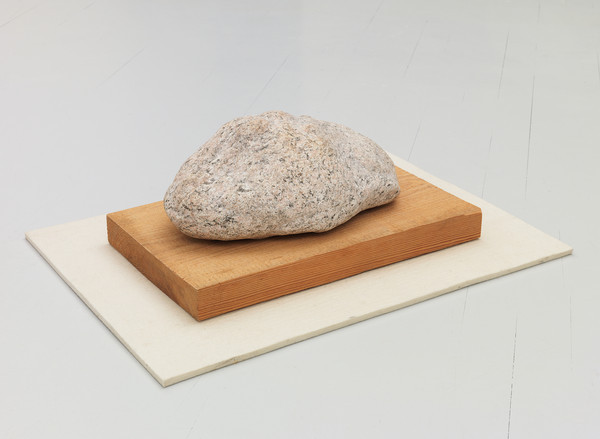Raimer Jochims
16 Sep - 31 Oct 2015
RAIMER JOCHIMS
Bilder und Steine von 1867 bis 2015
16 September - 31 October 2015
The central theme of Jochim’s work is the creation of works that explore the nature of color and its perception. But even though the work groups Verläufe (1962 – 1973/4) and Form der Farbe (from 1974 onwards) can be superficially understood as color field painting, the artist is interested neither in formal abstraction (i.e., reduction) of shapes, nor in an expressive or symbolic representation of motifs or content. Rather, Jochims engages with the very identity and being of color.
While the Farbverläufe [color progressions] created in the 1960s still refer to the then contemporary Color Field painting – especially to Ad Reinhardt and Mark Rothko – by eschewing rectangular formats (“color is not...”), Jochims began developing his subsequent works purely from color. The often multi-layered color combinations, rich in contrast, present a visual substance of processes, energies, and perhaps inherent characteristics: modest, strong, exciting, balanced. This dynamic shouldn’t be understood in a psychologizing way, nor merely phenomenologically; rather, it results from the viewing experience the artist creates through his choice of colors, their application, and the shapes of their supports.
In spite of the sometimes rounded, wave-like or jagged shape of the chipboards whose broken edges show the layers of paint, the works don’t become objects in an emphatic sense (which can often happen with such “shaped canvases” by other artists); rather, they seem to really consist just of color.
In a process that takes years, Jochims treats and works the stones that in an interplay with an underground of rectangular wood and felt parts, give voice to the essential features of these quite divergent materials. He has been making these stones since 1976 from found natural stones; the artist works on their surface with a chisel, until they are “as differentiated as necessary, and as taut as possible” (Jochims). Both with the chiseling as well as with the reception of the stones, the artist associates sensitivity, humility, and permanence. Their relationship to the earth manifests itself in their origin as well as their presentation on the ground. In their organic forms, they link above and below, left and right, front and back, thus balancing out the rectangular spaces where they are presented.
Using an approach that combines positivist (“seeing means not succumbing to sensuality”, work note of 14 April 1997) and spiritual (“to give energy, not consume it”) elements, Jochims aims for an abstraction that wants to be neither less nor more than representation. Believing in a cosmic order of the world, Jochims wants the beholder to have a constructive, “life-sustaining” visual experience that goes far beyond just training the gaze.
Raimer Jochims, born 1935 in Kiel. Studied philosophy and art history in Munich, taught at the art academies in Karlsruhe and Munich (1967–1971); professor at the Frankfurt Kunsthochschule (Städelschule) für Freie Malerei und Kunsttheorie (1971–1997). The artist lives and works in Maintal-Hochstadt near Frankfurt am Main.
Bilder und Steine von 1867 bis 2015
16 September - 31 October 2015
The central theme of Jochim’s work is the creation of works that explore the nature of color and its perception. But even though the work groups Verläufe (1962 – 1973/4) and Form der Farbe (from 1974 onwards) can be superficially understood as color field painting, the artist is interested neither in formal abstraction (i.e., reduction) of shapes, nor in an expressive or symbolic representation of motifs or content. Rather, Jochims engages with the very identity and being of color.
While the Farbverläufe [color progressions] created in the 1960s still refer to the then contemporary Color Field painting – especially to Ad Reinhardt and Mark Rothko – by eschewing rectangular formats (“color is not...”), Jochims began developing his subsequent works purely from color. The often multi-layered color combinations, rich in contrast, present a visual substance of processes, energies, and perhaps inherent characteristics: modest, strong, exciting, balanced. This dynamic shouldn’t be understood in a psychologizing way, nor merely phenomenologically; rather, it results from the viewing experience the artist creates through his choice of colors, their application, and the shapes of their supports.
In spite of the sometimes rounded, wave-like or jagged shape of the chipboards whose broken edges show the layers of paint, the works don’t become objects in an emphatic sense (which can often happen with such “shaped canvases” by other artists); rather, they seem to really consist just of color.
In a process that takes years, Jochims treats and works the stones that in an interplay with an underground of rectangular wood and felt parts, give voice to the essential features of these quite divergent materials. He has been making these stones since 1976 from found natural stones; the artist works on their surface with a chisel, until they are “as differentiated as necessary, and as taut as possible” (Jochims). Both with the chiseling as well as with the reception of the stones, the artist associates sensitivity, humility, and permanence. Their relationship to the earth manifests itself in their origin as well as their presentation on the ground. In their organic forms, they link above and below, left and right, front and back, thus balancing out the rectangular spaces where they are presented.
Using an approach that combines positivist (“seeing means not succumbing to sensuality”, work note of 14 April 1997) and spiritual (“to give energy, not consume it”) elements, Jochims aims for an abstraction that wants to be neither less nor more than representation. Believing in a cosmic order of the world, Jochims wants the beholder to have a constructive, “life-sustaining” visual experience that goes far beyond just training the gaze.
Raimer Jochims, born 1935 in Kiel. Studied philosophy and art history in Munich, taught at the art academies in Karlsruhe and Munich (1967–1971); professor at the Frankfurt Kunsthochschule (Städelschule) für Freie Malerei und Kunsttheorie (1971–1997). The artist lives and works in Maintal-Hochstadt near Frankfurt am Main.

